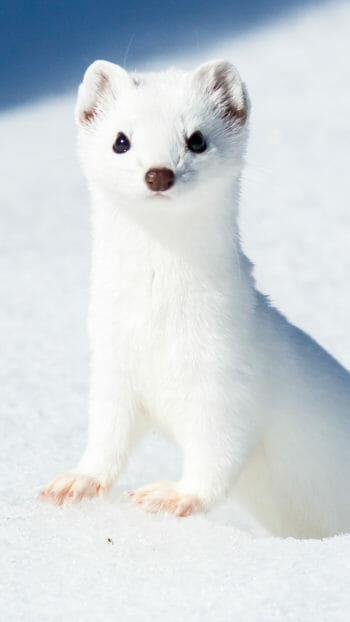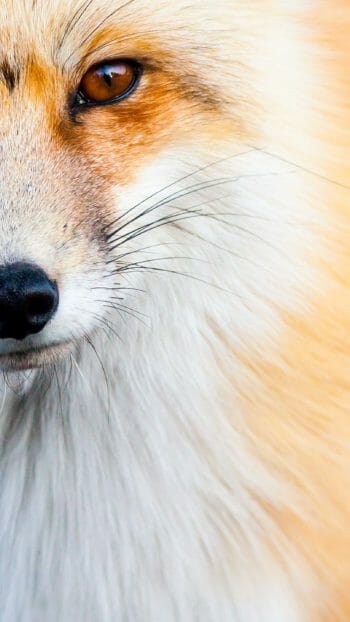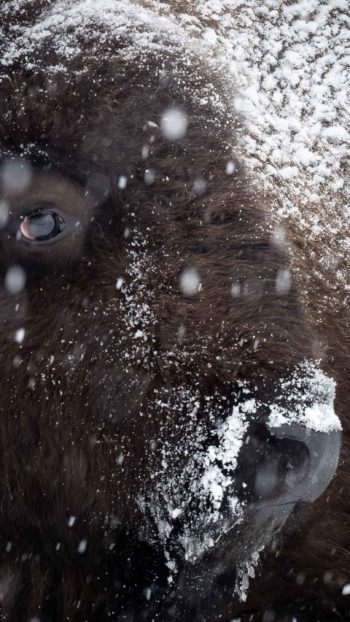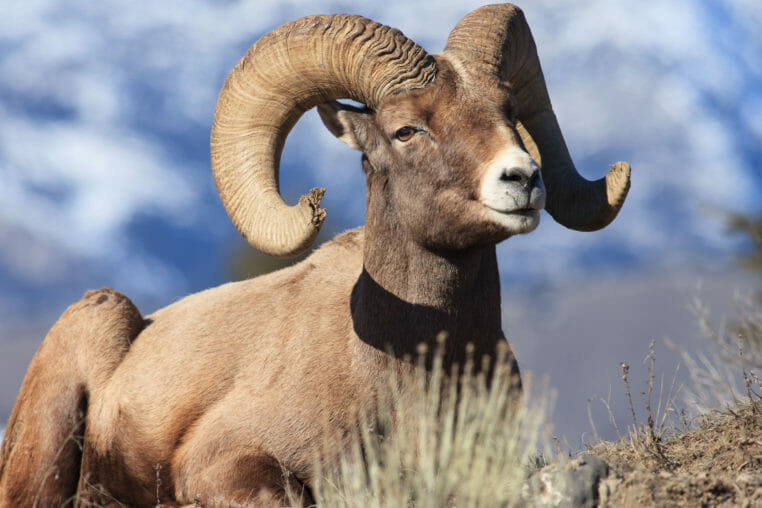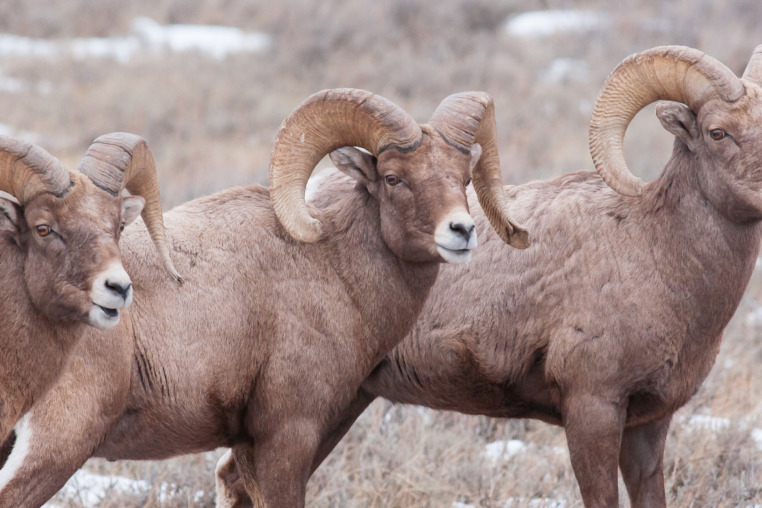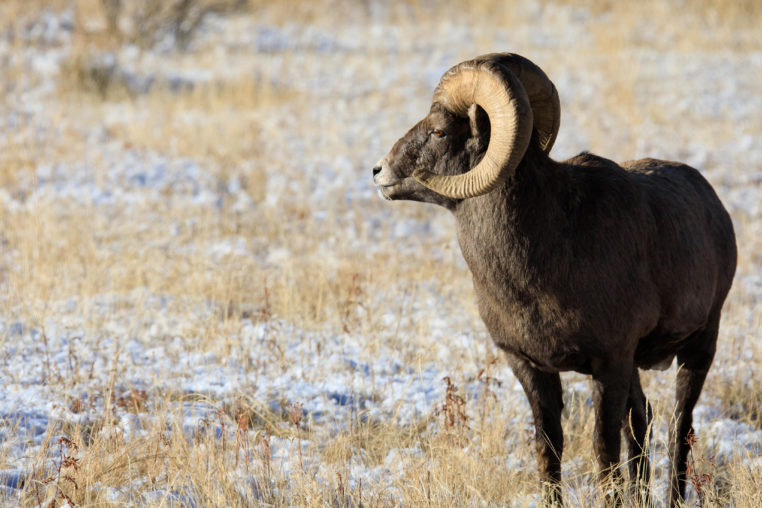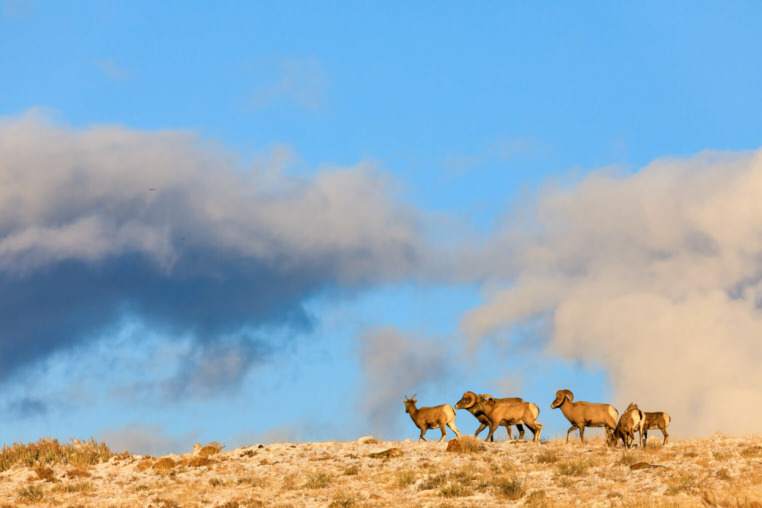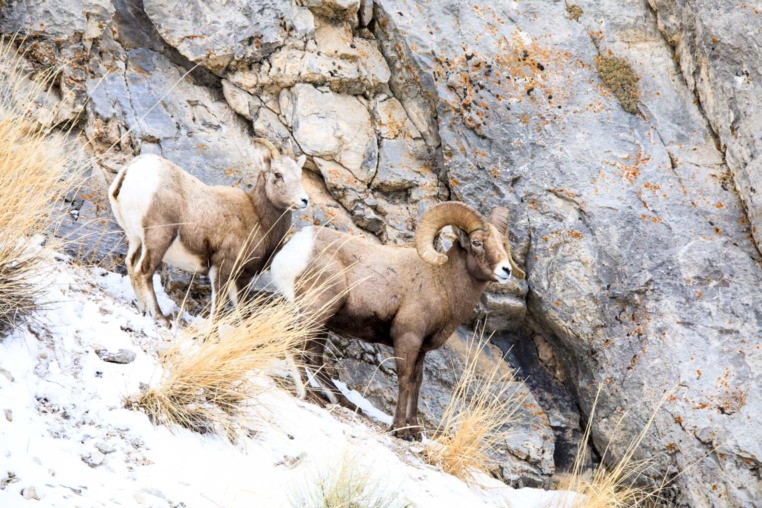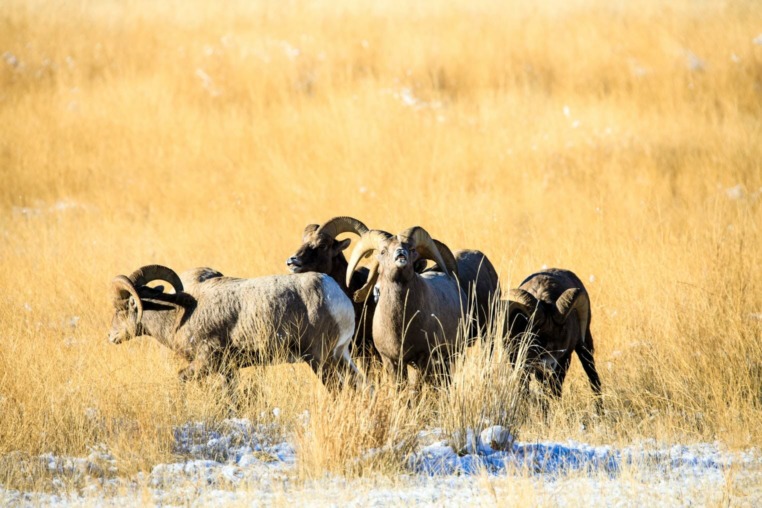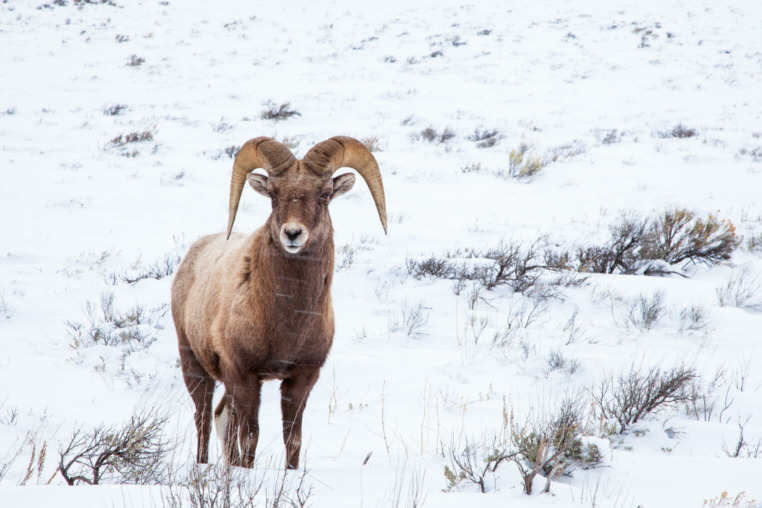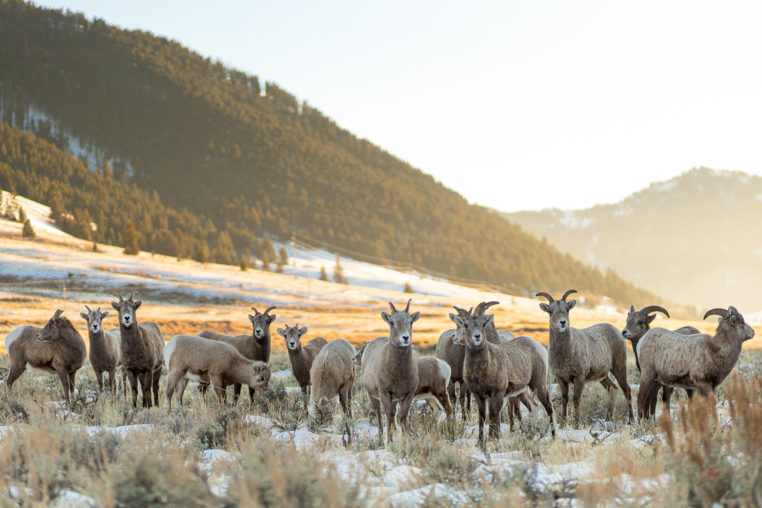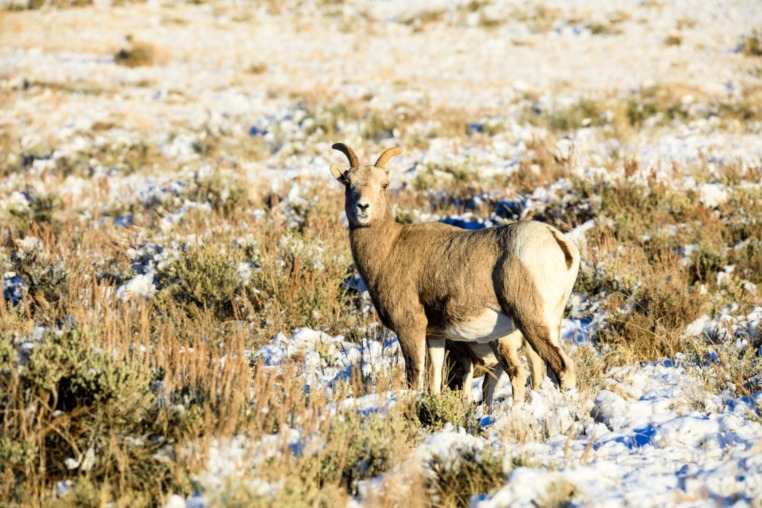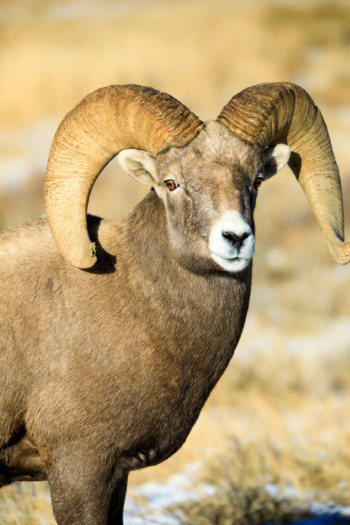
Ovis canadensis
There are three species of wild sheep across North America: the bighorn sheep, the Dall sheep, and the Stone sheep. The sheep that reside in the Greater Yellowstone Ecosystem are the largest of them all, the Rocky Mountain bighorn sheep. These stocky sheep are built to withstand harsh winter climates with thick fur and bulky stature. They can weigh anywhere between 150-300 pounds with males on the larger side. A pair of their enormous horns alone can weigh up to 30 pounds!
Wildlife Viewing
- Yellowstone
- Jackson Hole
Book Online
Watch For Wildlife On These Tours
About
The Ultimate Mountaineers
Bighorn sheep are known for their incredible acrobatics in impossibly steep terrain. Adapting to rugged cliff faces keeps them safe from many predators as they are able to leap and bound at breathtaking speed. They may not look like an animal that could effortlessly scale a rocky precipice, but their strong legs and specialized hooves help them move with ease. Their cloven hooves are flexible and have a rubber-like surface on the bottom of them, helping to grip onto even the smallest protrusion.
A Dramatic Rut – Natural Helmets
Bighorn sheep are the latest ungulates in the region to breed with the height of the rut around December, after they descend to lower elevations to their winter range. Rams will challenge each other to duals while ewes look on. Two challengers will size each other up visually, and if nobody backs down, the battle begins. Both rams rear up and catapult toward each other, lower their heads, and crack their horns together at an eye-watering 20 miles an hour, sending an echoing crack! tumbling through the hills. This repeats until one ram relents and retreats. The dominant ram establishes his rank in the herd and will mate with most of the breeding females.
The physiology of a bighorn sheep ram is one of the most fascinating evolutionary traits. Their curled horns are made of keratin, which is the same tissue that makes up your hair and fingernails, and its flexibility absorbs much of the shock on impact. The science goes even further than that, however. Along with a thicker and heavier skull, there is an additional type of bone in a section of the horn that is more foam-like, with pockets of air within it that also absorb a great deal of shock. Recent studies show that these animals don’t escape completely unscathed; post-mortem brain samples show signs of early brain injury, but considering how much of a beating their skulls take, that is extremely impressive! Scientists study the physiology of bighorn rams for bioinspired ways to develop protections for pro athletes to avoid major brain injuries throughout their careers.
Threats to Bighorn Sheep
While these acrobatic sheep are adept at avoiding predators for the most part, they face other challenges that threaten their survival in the GYE. Habitat fragmentation reduces access to viable habitats that they need throughout the year, leaving them vulnerable to vehicle strikes and reduced grazing.
One of the biggest threats to sheep is disease. Pneumonia plagues the herds in and around Jackson Hole, at times needing intervention from local wildlife agencies. The pneumonia was passed on to wild herds from domestic sheep, so mitigating close contact with domestic herds is important. A new virus has been detected in the herd that winters on the National Elk Refuge- the orf virus. This virus causes scabby sores to develop on their lips, muzzle, and in their mouths. While most individuals recover from these symptoms within a few weeks, infected sheep are susceptible to secondary infections that can be dangerous.
Our vehicles carry salt on them from driving on treated winter roads, attracting wildlife to approach and lick it off. Bighorn sheep do this in areas where they winter in low elevations, such as the Elk Refuge. When we allow this to happen, exposure to these viruses becomes far more concentrated as multiple sheep are licking the same area. Humans are also susceptible to the orf virus, so it is important for the health of both the sheep and ourselves to prevent this behavior.
Where Can I Find Bighorn Sheep?
During the summer months, bighorn sheep reside in high elevations on steep mountain slopes. Typically, the only way to see them is through a spotting scope from a great distance if you know where to look. Sylvan Pass by the east entrance of Yellowstone has great bighorn sheep habitat, so sometimes you can encounter them there right by the roadside. The winter months are the best for bighorn sheep watching. The deep snow in higher elevations pushes most sheep down lower in search of more protected winter ranges. Miller Butte on The National Elk Refuge is one of these winter ranges making bighorn sheep one of the most abundant winter wildlife species, sometimes even right on the road!
FAQs
What species of wild sheep live in Yellowstone?
The Rocky Mountain bighorn sheep is the only wild sheep species found in the Greater Yellowstone Ecosystem. They are the largest of North America’s three wild sheep species, which also include the Dall sheep and Stone sheep.
How much do bighorn sheep weigh?
Bighorn sheep typically weigh between 150–300 pounds, with males (rams) being larger than females (ewes). Their massive, curled horns can add another up to 30 pounds to their overall weight.
How do bighorn sheep survive Yellowstone’s winters?
Bighorn sheep are well-adapted to harsh mountain climates. Their thick coats, stocky build, and sure-footed climbing ability allow them to survive cold temperatures and snowy conditions in steep, rocky habitats where predators are less likely to reach them.
Where is the best place to see bighorn sheep in Yellowstone?
Bighorn sheep are most often seen in rocky cliffs, canyons, and alpine meadows where they can quickly escape predators. In Yellowstone, they are frequently spotted near Lamar Valley and the Yellowstone River Canyon. In Jackson Hole, a herd spend the winters on the National Elk Refuge.
How long do bighorn sheep live?
In the wild, bighorn sheep typically live 10–15 years, though many don’t reach that age due to predators, harsh winters, and disease. Older rams can often be identified by their heavily worn and deeply curled horns.
Further Reading
What Animals Will I See on the National Elk Refuge During the Winter?
Nov 1, 2024
Winter in Jackson Hole is a season of stunning beauty. In contrast to the bustling, busy summer season, the crisp winter air and the backdrop of snowy white mountains transforms the landscape into a winter wonderland.
5 Things To Do In Jackson Hole This Winter
Feb 11, 2025
Jackson Hole isn’t just for thrill-seekers—it’s also a wildlife lover’s dream come true. In winter, the animals in Grand Teton National Park come down to lower elevations, making it the perfect time to spot wildlife like elk, bison, mule deer, and coyotes.

